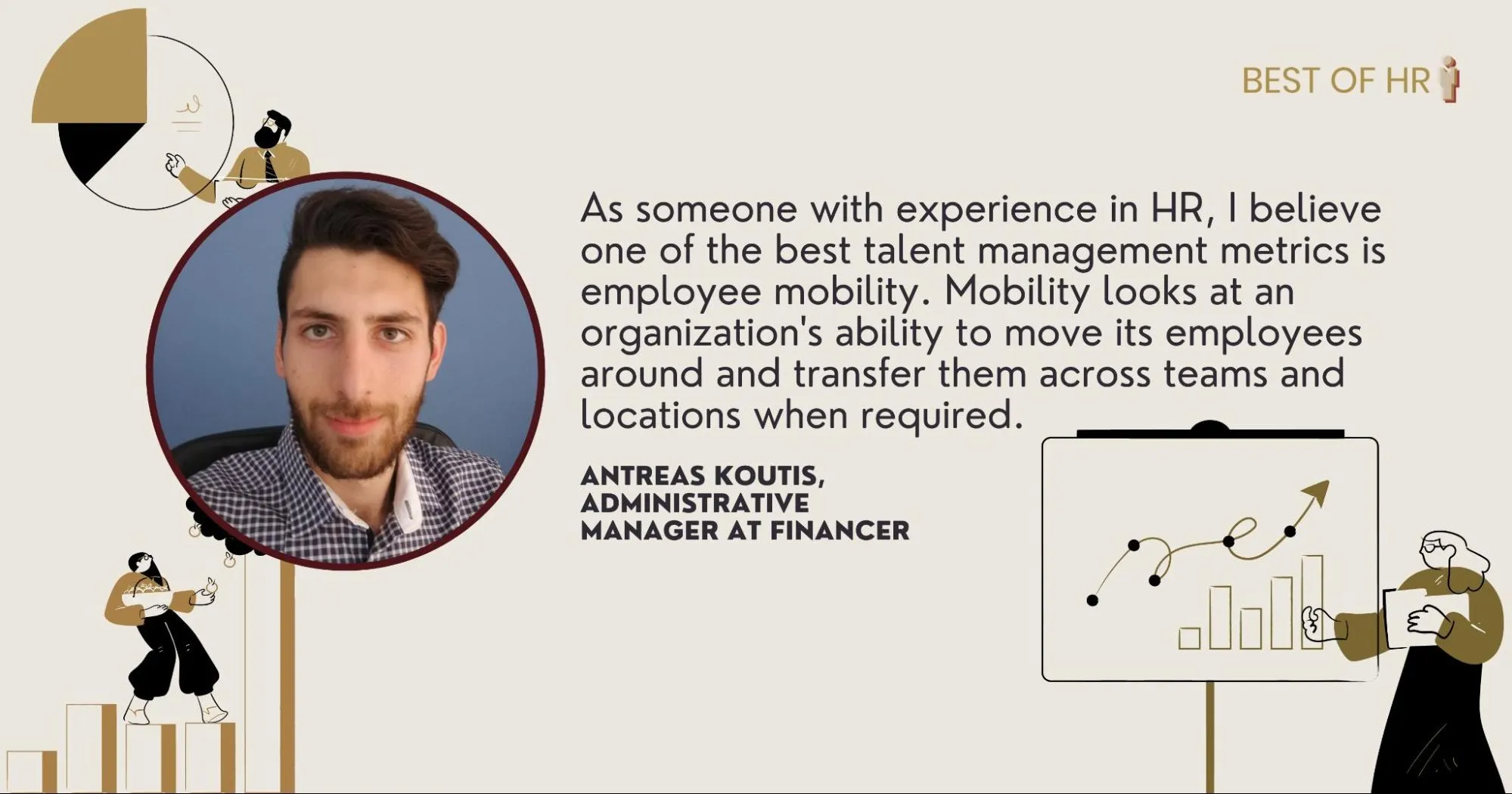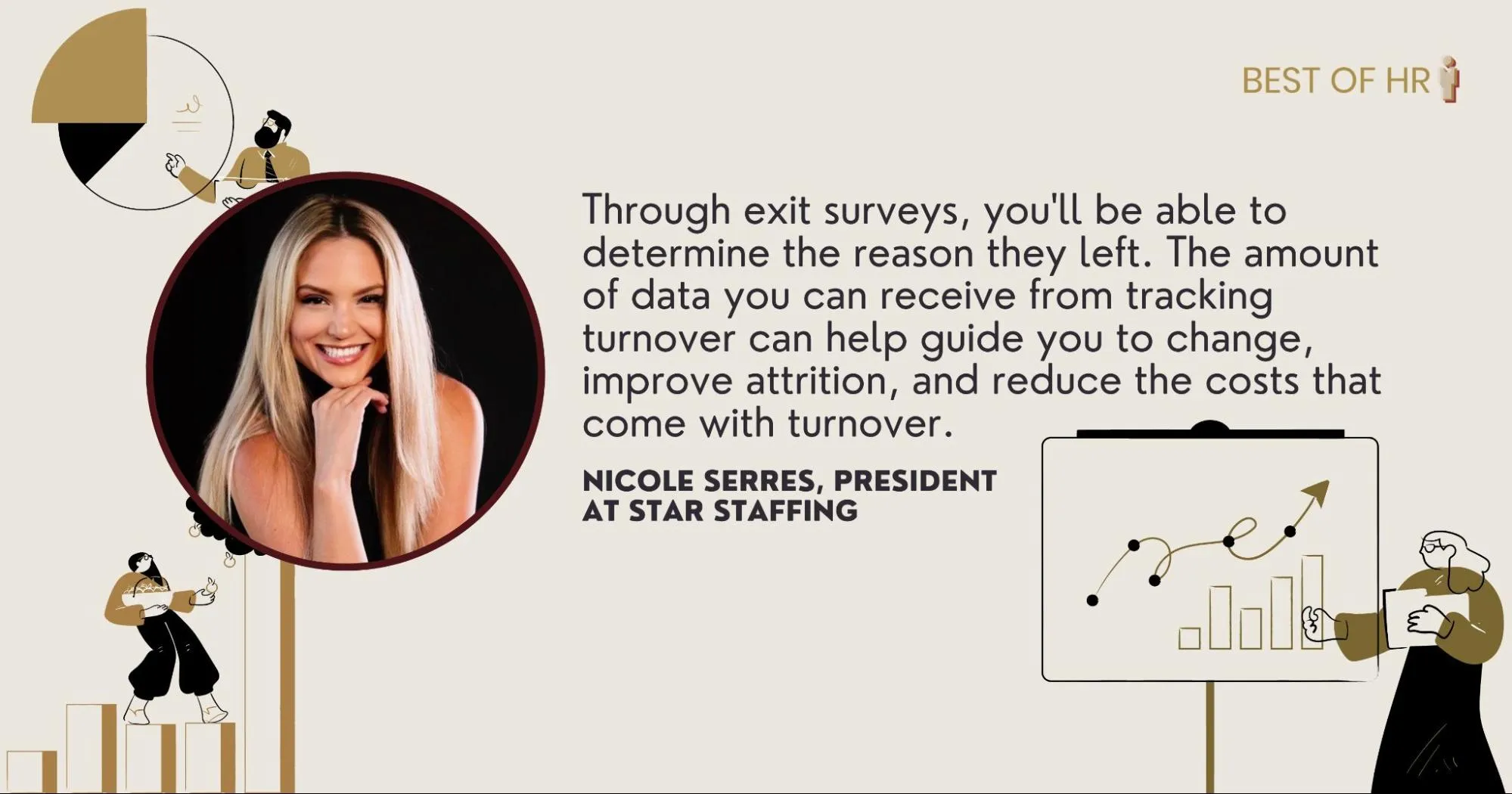What are some best practices for talent management metrics?
From employee mobility to net talent exporter, here are 10 answers to the question, “What are the most important talent management metrics, and why?”
- Employee Mobility
- Diversity and Inclusion
- Turnover
- Retention Rate
- Match the Metric to the Goal
- A Baseline of Critical Roles
- Number of Ready-Now Successors
- Employee Engagement
- High-Potential Talent
- Net Talent Exporter
Employee Mobility
As someone with experience in HR, I believe one of the best talent management metrics is employee mobility. Mobility looks at an organization’s ability to move its employees around and transfer them across teams and locations when required.
This metric can provide an understanding of which areas have a fluid pool of talent and what gaps need to be filled. Mobility can also help identify any internal issues stemming from resistance to change due to comfort in a certain role or team, which can hinder innovation and growth. It also helps enhance skills and knowledge while keeping a motivated workforce with fresh ideas, sparking creativity and collaboration.
Antreas Koutis, Administrative Manager, Financer

Diversity and Inclusion
Diversity and Inclusion (D&I), as a talent management metric, measures the representation of diverse groups within the organization and their level of integration and inclusion in the company culture.
It goes beyond simply tracking employee demographics, but focuses on creating a workplace environment where everyone feels respected and has equal opportunities for success. It is essential for several crucial reasons.
First, organizations with diverse and inclusive cultures have better financial performance, increased innovation, and higher employee satisfaction and engagement. Second, diverse teams bring different perspectives, experiences, and skills to problem-solving, leading to more creative and effective solutions. And finally, creating an inclusive workplace culture helps attract and keep top talent from diverse backgrounds, improving the overall talent pool.
Peter Bryla, Community Manager, ResumeLab
Turnover
Turnover is the best talent metric because it provides a great level of insight.
For starters, it can show issues in a department, or a shift, or under a certain manager. You can review the duration on the job to determine if there is a pattern of employees leaving. For example, if 20 employees left one department within the first 30 days, that would be an alarming sign that something is happening within those first 30 days in that department.
You can also track whether the exits are voluntary or involuntary. Is there a manager who keeps terminating employees? Through exit surveys, you’ll be able to determine the reason they left. The amount of data you can receive from tracking turnover can help guide you to change, improve attrition, and reduce the costs that come with turnover.
Nicole Serres, President, Star Staffing

Retention Rate
The retention rate defines the company’s overall success. Therefore, having a high turnover rate means high costs in terms of finance, productivity, and engagement. On the contrary, a high retention rate is cost-effective for a company, given the cost of replacing and training an employee. It also means more engaged employees, with higher morale and job satisfaction.
Karolina Kijowska, Head of People, US Visa Photo
Match the Metric to the Goal
Talent management metrics mean different things to different people; there is not one metric that is right for everyone. Instead, consider what the objective of your talent strategy is.
Are you trying to grow talent internally and reduce the number of external hires for senior roles? Are you trying to create more gender balance at the senior leadership level, or are you trying to reduce turnover? These are all great metrics, but which one is right for you?
Jane Ferré, Executive Career Coach, Jane Ferre Coaching
A Baseline of Critical Roles
When implementing a Succession Planning Strategy, most organizations defer to the ubiquitous use of the 9-box and the associated x/y metric of Performance and Potential. But why?
Most do so without strategic considerations of the organizational needs. At a minimum, consideration should be given to using Risk of Loss and the associated Impact of that loss on the role, department, and company goals.
Succession planning should not just be about promotions; it should also be about protecting institutional knowledge. Establishing a baseline of critical roles (and people) is a very meaningful metric to ensure business continuity.
Keith Meyerson, Director, Talent Management, POWDR
Number of Ready-Now Successors
In today’s increasingly dynamic environment, having the right successors when you need them is even more critical to the continuity of your business, making the percentage of critical roles with a “ready-now” successor a metric to watch.
There are four things to consider. First, career conversations need to feed succession discussions as the talent pipeline is only truly healthy if the ready-now individuals aspire to the role and will move into it when the time comes.
Second, consider the percentage of diverse successors. If needed, consider filling the pipeline at more junior levels to feed diversity into higher levels over the longer term.
Third, it’s a careful balance as, while you want ready-now successors, external offers will tempt many talented people away before the job they’re waiting for becomes available.
Finally, the most important work comes when the metric identifies gaps in succession, and we put a development plan in place to close them.
Nancy Lupinski, Founder and Consultant, Total Talent Management
Employee Engagement
Employee engagement is a critical talent management metric that is directly tied to a company’s financial performance. We correlate high levels of employee engagement with increased productivity, job satisfaction, and overall well-being, as well as reduced turnover.
We typically measure employee engagement through surveys, which ask about their level of satisfaction with their work. The results can then inform decisions about benefits, training programs, workplace culture, and other initiatives aimed at improving employee engagement.
Studies have shown that organizations with engaged employees have a higher financial performance. For example, Gallup found that companies with highly engaged employees had earnings per share that were 17% higher than those of companies with low engagement. Aon Hewitt found that organizations in the top quartile for employee engagement had 2.6 times higher earnings per share.
Tara Furiani, CEO and Host, Not the HR Lady
High-Potential Talent
While high performance is at the core, performance management systems focus on employees who don’t meet key deliverables, and high-performing talent is taken for granted. Because of this, skills gaps are identified, and we define training and development interventions for the former with few initiatives to nurture high-potential talent.
I believe “talent” in talent management should be taken even in the literal sense and see “high-potential talent” as an effective metric that measures the ratio of top performers to the rest of the employees. This metric will help build a leadership pipeline that can be groomed through executive coaching and solve for succession planning.
It will also have a positive impact on the morale of the team and send out a powerful message that high-performing talent is valued, which organizations can otherwise lose to competition. Last, a strong leadership pipeline also allows for a hiring strategy that will help lower hiring costs.
Enma Popli, Executive Coach, Enma Popli
Net Talent Exporter
Aside from getting objective results for the business, developing people is the most important function of a leader. Development can take many forms and can be difficult to measure, but one important measure is whether a leader is a net exporter of talent. In other words, how many people in that leader’s functional area are promoted up (or laterally) and out of their organization?
This tells us a couple of things. Is the leader effectively developing people to take on greater responsibility and provide greater value? Is the leader hiring people who can take on greater responsibility and provide greater value? Does the leader develop their bench so that they can export talent when their people are ready without sacrificing operations?
This metric drives an expectation that leaders actively engage in developing their people and create the circumstances for that development to pay dividends.
Thane Bellomo, Director, Talent Management and Organizational Development
Submit Your Answer
Would you like to submit an alternate answer to the question, “What is one best talent management metric and why?”

